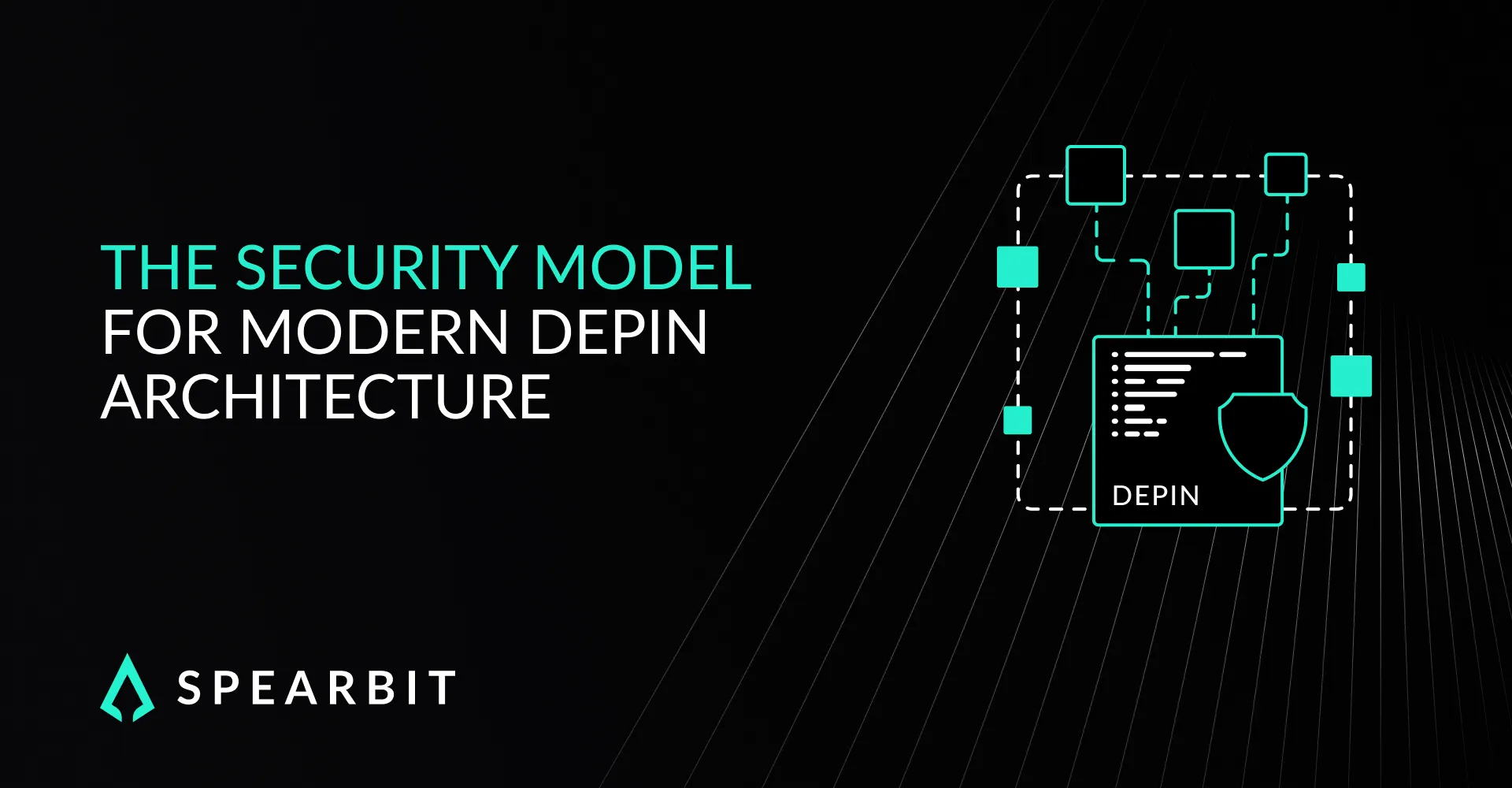Decentralized Physical Infrastructure Networks (DePINs) coordinate physical services using blockchain infrastructure. These systems reward participants for operating devices that provide wireless connectivity, data storage, compute capacity, energy balancing, and other physical functions. The protocol governs how resources are validated, compensated, and secured.
The sector now exceeds $34 billion dollars in combined market capitalization. DePIN organizations underpin infrastructure with real-world dependencies and economic significance. They face unique attack surfaces that extend beyond smart contract vulnerabilities into orchestration systems, physical devices, governance processes, and behavioral incentives.
This blog outlines a full-lifecycle Spearbit security model for DePIN protocols. It incorporates risk assessments observed across high signal security reviews, adversarial modeling, and implementation feedback from infrastructure-focused organizations.
Defining the DePIN Risk Surface
DePINs operate across interconnected systems. Each layer introduces independent risk domains:
- Smart contract logic responsible for staking, reward issuance, and slashing
- Physical devices that generate proofs, transmit data, and maintain network coverage
- Orchestration backends that coordinate node participation and protocol state transitions
- Governance mechanisms that define privilege distribution and upgrade control
Security assumptions in one layer often fail when implicitly extended to others. Robust DePIN architecture requires formal trust boundaries and enforced consistency between system layers.
Structural Security Benefits and Associated Risks
DePIN protocols provide architectural benefits through distributed operation, redundant pathways, and incentive-based coordination. Properly implemented, they reduce reliance on centralized infrastructure and allow for resilient fault recovery.
These benefits are conditional. Without structured safeguards, DePINs become vulnerable to:
- Collusion between nodes during low activity epochs
- Sybil-based reward inflation and false reporting
- Physical device spoofing or firmware compromise
- Governance capture through unchecked privilege distribution
Security must be explicitly engineered at each stage of protocol development. These systems do not inherit resilience from decentralization alone.
DePIN Risk Index

Security Across the DePIN Lifecycle
While a full-lifecycle approach provides the most comprehensive defense, many organizations engage at specific phases based on scope, maturity, and resource focus. Spearbit structures reviews to meet protocols where they are, while maintaining visibility across layers and continuity between cycles.
Each phase introduces unique risk exposure. Security reviews should be scoped accordingly.
Design Phase
Trust boundary modeling between contributors, coordination layers, user incentives, and administrative privileges Reward design that defends against exploitation and aligns with economic assumptions Threat modeling to identify high-impact failure paths before implementation
Development Phase
Validation of smart contract behavior under adversarial edge cases API stability, abuse prevention, and coordination logic validation Firmware review and update logic examination
Deployment Phase
Privilege separation validation and upgrade control enforcement Launch configuration review including parameters, governance, and operational safety Targeted penetration testing of orchestration and interface systems
Post-Launch
Monitoring integration for data integrity and anomaly detection Bug bounty design for firmware, orchestration, and contract behavior Patch workflow validation and regression prevention
Case Application: Validation at the Device-Orchestration Boundary
In one recent engagement, Spearbit conducted a structured review of a DePIN-like protocol that relied on automated asset tranching and dynamic configuration of collateral-backed lending pools. The architecture introduced orchestration complexity across wrappers, tick-based liquidity, and permissionless deployment logic.
The high-signal review focused on boundary assumptions between contract logic, off-chain data flows, and user interface behavior. One critical design pattern involved redemption queue scanning for pooled assets, which introduced scenarios where zero-value operations could revert, leading to withdrawal failure and funds being stuck. This was not detectable through standard contract logic analysis alone.
Additional layers of the engagement surfaced integration risks related to pool legitimacy, token compliance, and user configuration transparency. By auditing orchestration paths, reviewing symbolic consistency, and modeling attack paths through wrapper misuse, the review surfaced a series of issues that would have otherwise bypassed isolated contract assessments.
All identified issues were resolved and validated through retesting. The protocol’s deployment process was upgraded with stricter configuration enforcement and improved off-chain handling of rounding edge cases and non-compliant tokens.
This case reflects the importance of full-lifecycle and cross-domain validation in DePIN systems, where execution flows span beyond chain-level logic.
DePIN-Specific Use Cases and Security Implications
Storage Networks
These organizations distribute encrypted data across independent storage nodes. Threats include falsified proofs, delayed retrieval, and unauthorized access. Protocols require accurate replication proofs, slashing enforcement, and client-side verification tools.
Wireless Connectivity
DePINs that reward geographic network coverage face location falsification, firmware bypass, and participation drop-off during low demand windows. Devices require secure location proofing and tamper-resistant hardware verification.
Energy Systems
Ecosystems integrating smart grids or energy routing must ensure accurate metering, anti-tamper enforcement, and secure incentive structures. Device calibration, firmware protection, and dynamic pricing security are essential.
Sensor Meshes
Decentralized networks of environmental or location sensors must guard against data spoofing and duplicate reporting. Reputation-weighted aggregation and cross-node anomaly detection are required to maintain accuracy and trust.
Strategic Security Model for DePIN Protocols
Organizations building DePIN protocols must integrate four operating principles:
Isolated Validation
Each component of the system must be validated independently. Contracts, firmware, orchestration, and governance each require domain-specific review methodologies.
Adversarial Simulation
Security reviews must reflect realistic attack conditions. This includes modeling economic manipulation, coordinated collusion, partial failure states, and low-density node participation.
Continuous Engagement
Security must remain embedded through the protocol lifecycle. Long-term collaboration with experienced researchers enables context preservation and response continuity.
Cross-Layer Visibility
Effective security requires shared visibility across smart contract behavior, firmware performance, API endpoints, and governance transactions. Systems that lack telemetry or integration between these domains remain vulnerable to blind spots.
Roadmap for Secure Implementation

Conclusion
DePIN protocols integrate physical infrastructure with on-chain coordination. Their complexity exceeds that of purely digital systems and introduces risks not addressable through isolated contract reviews.
Security must be embedded from architectural planning through operational scaling. Full-lifecycle engagement, adversarial modeling, and layered validation are required to maintain trust, functionality, and resilience in an environment shaped by real-world dependencies and unpredictable adversaries.
Organizations operating in this space benefit from structured security partnerships that can deliver multi-domain visibility, threat-informed design reviews, and scalable coverage over time.
To engage with a full-lifecycle security program for your DePIN system, contact us.




